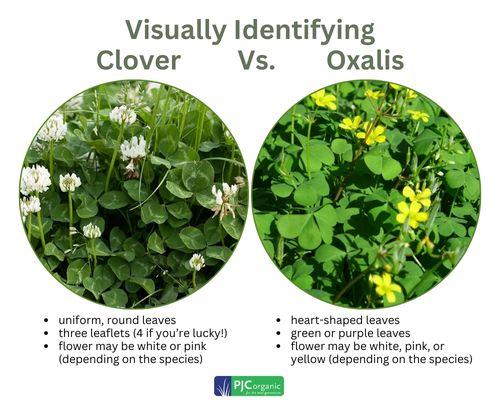Spring has sprung and soon so will the weeds. As the days get longer and the soil begins to warm, turf grass is coming out of winter dormancy and the race to establish a dense stand of turf begins. When scouting lawns and athletic fields for weeds, it’s important to ask yourself why a particular weed is there. The short answer is: underlying soil conditions. When evaluating areas, different weeds tell different stories as to what’s going on with the soil. Given the wet, cool New England Spring we’re having, I expect to see more chickweed and clover this season. Today, I’ll cover how to control clover all-naturally, and next week I’ll discuss chickweed.
The Benefits of Clover
First, I need to emphasize the fact that clover’s classification as a “weed” is up for debate. Notably, this plant used to be included in grass seed blends. Clover can be a beneficial plant because of its ability to obtain nitrogen from the atmosphere and ‘fix’ it in nodules on its roots. Additional benefits of clover include: making lawns appear greener, creating a fuller lawn, pollination, outcompeting invasive weeds, and requiring less mowing. Nevertheless, given people’s disdain for clover, we’ll talk about how it can at least be mitigated all-naturally.
Characteristics of Clover
Clover is a rapid spreader. This cool-season perennial is more likely to establish itself during a cool, wet spring before the turf grass starts growing. Clover will germinate in soil temperatures as low as 45°. Conversely, the optimum growth temperatures for cool season turf grass is: roots 50° – 65°; seed in the 60° – 65° range; and shoots 60° – 75°. Therefore, in the Spring, clover is the first competitor to show.
It thrives in soils with low pH which is also an indicator of low fertility for turf grass. Additionally, when turf grass is thin, light can reach the soil surface and encourage the clover to germinate. Clover spreads by seed and creeping branched stems. Because clover seeds have a hard coat they can survive in the soil for long periods of time until conditions are right to encourage their germination.
When talking about clover, I should mention that many people mis-identify this plant and confuse it with Oxalis. The image below highlights that general visual difference between the two.

Cons of Clover
While there are benefits to clover, it’s important to note that this plant can be problematic for athletic fields. Clover compromises the integrity of a playing surface. It doesn’t suit athletes playing sports because it doesn’t allow for consistent ball rolling speed. Also, inconsistent field surfaces create difficulty for cleats to gain traction when changing direction. It goes without saying that—despite its benefits—some people just don’t want clover in their lawn. So, to control clover all-naturally we’ve seen the efficacy of our 6 recommendations below…
How to Prevent and Treat Clover
Since there are circumstances where we want to minimize clover, be sure to do so without harsh chemicals. PJC’s practical approach recommends the following products and cultural practices to control clover all-naturally:
-
Improve Turf Coverage
Have an aggressive over-seeding program. Overseed a minimum of twice a year with high quality grass seed suitable for the site. In a perfect world, overseeding should occur prior to May 15th and between August 15th and September 15th. This will help establish a denser stand of turf, which means light won’t be getting through a thin turf stand and encouraging clover to germinate.
-
Fertilization
Assess your fertility program. Typical target is 2lbs/1,000sf in a season. This tends to be a middle of the road approach. If this is not meeting expectations, add a 4th All-Natural Organic Fertilizer application or change to a higher “N” product – possibly PJC’s ProHealthy Turf 7-0-2+ or PJC’s OMRI-Listed ProHealthy Turf 8-0-6.
-
Focus on Organic Matter
Focus on improving levels of Organic Matter (OM). Organic Matter is important to help buffer the soil conditions. Improving OM is best done through top-dressing and raising the height of cut. The higher the height of cut the deeper the roots, that add to the level of OM as they die and slough off.
-
Dial in Your Mowing Practices
Maintenance of Height of Cut. It is important to note that with a higher height of cut the turf grass will exhibit improved stress resistance, appearance and additions to organic matter. Following correct mowing protocol throughout the growing season is a critical cultural practice that can’t be overstated.
-
Perform a Soil Test
Soil testing gives you a baseline of where your soil is at and dictates product selection. When you soil test with PJC, we provide you a report with product recommendations in easy-to-understand format. Additionally, our Master Product Application Charts list by site product, # of bags, # of applications and when to apply for the season. We update it as new soil tests are taken—saving you time and making product decisions easy.
-
Contact PJC!
We make the whole process a lot simpler for you. We don’t only manufacture and distribute organic fertilizer and soil amendments. We work with landscapers, schools, and municipalities to implement organic turf care programs successfully.
We’ve said it before and we’ll say it again (and again)…Address soil conditions and work in the Spring and Fall to establish a dense stand of turf that will crowd out weeds. It is possible to control clover all-naturally. Reach out for info on how we can help you implement organic turf care successfully!








